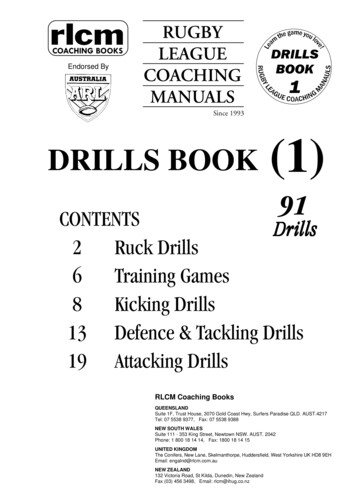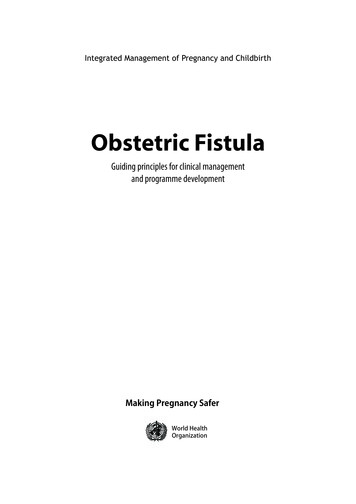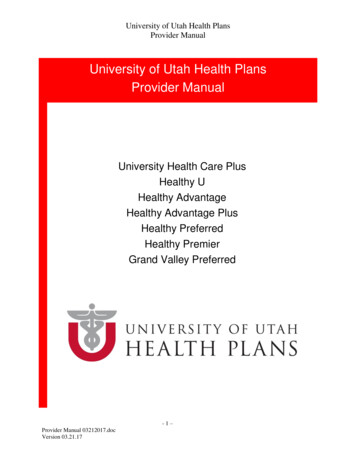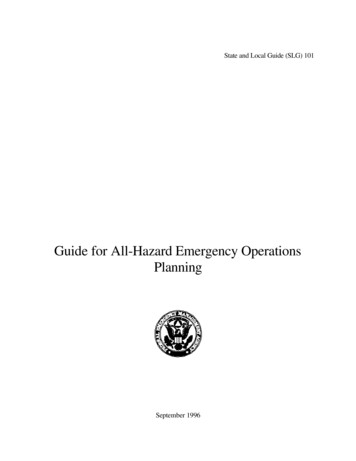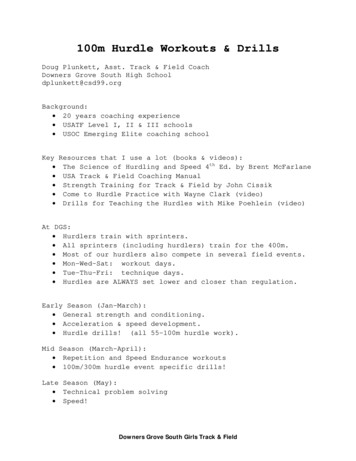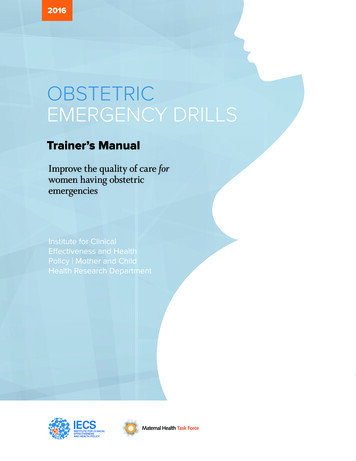
Transcription
2016OBSTETRICEMERGENCY DRILLSTrainer’s ManualImprove the quality of care forwomen having obstetricemergenciesInstitute for ClinicalEffectiveness and HealthPolicy Mother and ChildHealth Research Department
IntroductionThis manual was developed by the Institute for ClinicalEffectiveness and Health Policy (IECS) from Argentina aspart of the Health Facility Networking for Maternal HealthProject, supported by the Maternal Health Task Force atthe Harvard T.H. Chan School of Public Health.COORDINATIONEDITORFERNANDO ALTHABEKATIE MILLAREZEQUIEL GARCÍA ELORRIOTECHNICAL REVIEWRESEARCH TEAMRIMA JOLIVETDANIELA S. COLACIKATHLEEN MCDONALDAGUSTINA MAZZONIKATIE MILLARMARIA BELIZÁNSEBASTIÁN GARCÍA MARTÍISBN 978-0-692-71473-7DESIGNSOMEONE CREATIVE
AcknowledgementsThis manual was developed by the authors with support from the MaternalHealth Task Force (MHTF) through Grant #01065000621 from the Bill &Melinda Gates Foundation.The development of this manual has drawn heavily upon the expertadvice from the obstetric emergency drills team in Argentina. Thanks toDr. María Julia Cuetos, Dr. Daniel Lipchak, Carolina Nigri, Patricia Perezand Mariano Ulanovsky.Thanks to Dr. Anne Austin from the MHTF and to our colleagues fromSaint Paul’s Millennium Medical College in Ethiopia and St. John’s ResearchInstitute and the Karnataka Health Promotion Trust in India for their insightfulfeedback on ways to improve this manual. We’d like to give another thankyou to our MHTF colleagues: Katie Millar for her technical and clinicalexpertise, feedback, and edits and to Kayla McGowan and Julia Ofmanwho provided copyediting support.It is the authors’ intention that this training manual be made widely andfreely available for use and adaptation by other facilitators. If you are usingthis manual to guide your own training, we ask that you acknowledge thesource during your training program. We are keen to hear about yourexperiences using the manual, both positive and negative. Please directyour feedback to mhtf@hsph.harvard.edu.
Contents1Objective2Description of obstetric emergency drills3Rationale for conducting obstetricemergency drills41. Tools for teaching and learning1.1 How do we define learning in this context?1.2 What is teaching?1.3 The importance of observing1.4 The importance of listening1.5 The freedom to ask questions1.6 The importance of giving andreceiving feedback1.7 Other teaching and training resources82. What is needed to implementobstetric emergency drills2.1 Appropriate facility environmentand consent2.2 Implementation team/trainers2.3 Obstetric emergency drill participants113. How to do obstetric emergency drills3.1 Overview3.2 The scenario script3.3 Supplies needed for the obstetricemergency drill3.4 Step-by-step process13 4. Debriefing session4.1 Four key elements of a debriefing4.2 Tips for the debriefing session4.3 Debriefing step-by-step16 General tips for the implementationteam/trainers17 Annex 1: Facility Readiness AssessmentA. Key informant interviewer guideSection I: Background information ofkey informantSection II: Explanation and assessmentof implementation feasibilityB. Facility checklist25 Annex 2: Postpartum hemorrhage scenario31 Annex 3: Postpartum hemorrhage scenario:Observer debriefing guide and checklistsObserver debriefing guideObserver checklists by topic1. Communication with theobstetrics client2. Communication among obstetricemergency drill participants3. Teamwork: Organization andleadership4. Calling for help5. Diagnosis and treatment6. Human resources and equipment40 Annex 4: Eclampsia scenario45 Annex 5: Eclampsia: Observer'sdebriefing guide and checklistsObserver debriefing guideObserver checklists by topic1. Communication with theobstetrics client2. Communication between obstetricemergency drill participants3. Teamwork: Organization andleadership4. Calling for help5. Diagnosis and treatment6. Human resources and equipment
2016 TRAINER’S MANUAL OBSTETRIC EMERGENCY DRILLS TO IMPROVE THE QUALITY OF CARE FOR WOMEN HAVING OBSTETRIC EMERGENCIESObjectiveThis manual is intended for members of a quality improvement team froman obstetrics department in a facility that manages deliveries and receivesemergency referrals. Its purpose is to teach a team to run obstetric emergencydrills on a random schedule within the obstetrics unit, to help clinical staffevaluate and improve their responses to obstetric emergencies.The objective of this manual is to describe the procedures and to providethe necessary tools to conduct obstetric emergency drills followed by debriefing sessions to improve facility quality and emergency preparedness.This manual is not meant to provide clinical guidelines. Content of drillscenarios should be corroborated with evidence-based guidelines andfacility protocols. The manual should be used as a training tool and areference during implementation of obstetric emergency drills.This manual is neither a “training of trainers” manual nor a participantmanual for clinicians participating in obstetric emergency drills.1INSTITUTE FOR CLINICAL EFFECTIVENESS AND HEALTH POLICYMATERNAL HEALTH TASK FORCE
2016 TRAINER’S MANUAL OBSTETRIC EMERGENCY DRILLS TO IMPROVE THE QUALITY OF CARE FOR WOMEN HAVING OBSTETRIC EMERGENCIESDescription of obstetric emergency drillsAn obstetric emergency drill is a method for practicing the managementof an obstetric emergency in facilities where emergency obstetric careis delivered.Luckily, devastating obstetric emergencies are rare. Without a wayfor clinicians to maintain knowledge and skills in managing obstetricemergencies, pregnant women are at risk of not receiving the care theyneed when they face life-threatening complications. Stepping outsideof the classroom, obstetric emergency drills—simulations of managinga woman with the most common obstetric emergencies—allow nurses,midwives and physicians to gain and maintain knowledge, build skillsand teamwork, and improve communication to safely manage thesecomplications.An obstetric emergency drill allows providers to practice applying theirskills and knowledge to manage infrequent, but deadly, events in thesame setting as they would manage a real emergency – in this case, theirown facility.The drill involves (1) a person who assumes the role of an obstetricsclient experiencing an obstetric emergency and (2) health providers fromthe facility who simulate the emergency management of the obstetriccomplication as a team (including an obstetrician, a midwife, and a nurse).Participating personnel are not notified of the obstetric emergency drillin advance and have to react as if it were a real emergency.Obstetric emergency drills should be conducted at a frequency that isappropriate for maintaining skills of clinical staff. This may be twice aquarter, once a quarter, or twice a year, depending on need. The first drillwill be used to detect latent problems and to plan and implement correctivemeasures. The following drills will make it possible to evaluate if thecorrective measures were effective and improve weaknesses in obstetricemergency management.2INSTITUTE FOR CLINICAL EFFECTIVENESS AND HEALTH POLICYMATERNAL HEALTH TASK FORCE
2016 TRAINER’S MANUAL OBSTETRIC EMERGENCY DRILLS TO IMPROVE THE QUALITY OF CARE FOR WOMEN HAVING OBSTETRIC EMERGENCIESRationale for conducting obstetric emergency drillsSimulation is a means of training to improve the management of obstetricemergencies. As in aviation and fire emergencies, the relatively low frequencyand unpredictability of life-threatening obstetric emergencies makessimulation-based training the most appropriate method for training healthproviders in order to gain and maintain competence in managing obstetricemergencies.1 This modality has proven effective in improving providers’knowledge, attitudes, and clinical skills. Drills are currently used to trainproviders in the management of obstetric emergencies in the United States2and United Kingdom3, and the method presented in this manual has beensuccessfully implemented in India and Ethiopia.Obstetric emergency drills are scenario-based trainings conducted in ‘realtime’ in the normal working environment. These drills aim to test both thelocal emergency response system and protocols that facilities have in placeto manage obstetric emergencies. Drills can also be used to test professionalteamwork dynamics and individual providers’ skill and knowledge.3,4 Anadditional advantage of using drills is their low cost compared to settingup sophisticated training centers, and thus may be more appropriate inlow- and middle-income countries. The World Health Organization hasrecognized the development of locally effective and inexpensive solutionsfor training caregivers as a priority.5,6THE ADVANTAGES OF CONDUCTING AN OBSTETRIC EMERGENCY DRILL 3Improved professional practice and teamworkImproved performance of the health service as a wholeThe identification of areas for quality improvementFacility readiness for obstetric emergenciesINSTITUTE FOR CLINICAL EFFECTIVENESS AND HEALTH POLICYMATERNAL HEALTH TASK FORCE
2016 TRAINER’S MANUAL OBSTETRIC EMERGENCY DRILLS TO IMPROVE THE QUALITY OF CARE FOR WOMEN HAVING OBSTETRIC EMERGENCIES1. Tools for teaching and learning1.1 How do we define learning in this context?Learning implies some sort of transformation; it is the ability to do something that could notbe done before. One source of evidence that something was successfully learned is the abilityto demonstrate it; it is often said that the best way to learn something is by doing it. Thereare many examples of this kind of experiential learning, from learning to ride a bike andpublic speaking to writing a research paper or performing a clinical procedure.Trainers must have a clear understanding of their teaching goals while performing anactivity in order to facilitate a transformation of attitudes or behavior in participants.The key question in the design and implementation of obstetric emergency drills is,“Why do we do what we do?” The design of the training activity seeks to provide a spacefor self-reflection, self-evaluation andwillingness to improve. It is not anactivity that is meant to “certify” theTrainers must have a clear understandingability of the participants to manageof their teaching goals while performingobstetric emergencies, but rather isan activity.meant to allow participants to gain andpractice the skills that are needed to acteffectively when rare events occur.Drills and debriefings are often meaningful learning experiences for participants becausethey require a high level of participation and introspection. Although each person learnsdifferently, there are some features that are common to all learning experiences: A recognition of what one does not know, both current and previous ignorance A willingness to learn An obstacle to overcome Discomfort as one travels through the learning experience An increase in confidence at the end of the initial experience1.2 What is teaching?TEACHING BY DEMONSTRATING: THE TRADITIONAL MODELWe can characterize this model with the following attributes: A clear transmission of concepts needed to ensure learning An emphasis on the content The trainer is the leader and is in charge of the teaching and learning process,the one who knows how things are done and who shows others how to do them The student is passive, receptive, and does not know the new concepts If the training process succeeds, it is the trainer s achievement If the training process fails, it is the student’s failure There is no room for error or for not knowing The ability to respond correctly is given great value4INSTITUTE FOR CLINICAL EFFECTIVENESS AND HEALTH POLICYMATERNAL HEALTH TASK FORCE
2016 TRAINER’S MANUAL OBSTETRIC EMERGENCY DRILLS TO IMPROVE THE QUALITY OF CARE FOR WOMEN HAVING OBSTETRIC EMERGENCIESTEACHING BY FACILITATING: THE ALTERNATIVE MODEL USED IN OBSTETRICEMERGENCY DRILLSWe can characterize this model with the following attributes: Acknowledging that people learn in different ways In all cases, learning involves four domains: cognitive, sensory, emotional, and intuitive The student is the leader and hero in the learning process The student plays an active role and brings in prior learning experiences.New learning builds on prior learning The trainer is at the service of the student The trainer s role is to show how things are done and to facilitate the learning process The trainer’s responsibility is to get to know the students and promote their transformation The ultimate goal is to guide the students to improve their behaviors and attitudes Students learn from their mistakes. Mistakes are seen as a valuable resource for learning Not knowing is valued as a starting point for learning something new The ability to ask questions is given great valueWorking with drills requires that trainers adopt the “teaching by facilitating” paradigm. Akey aspect of this model is symmetry with participants. To achieve this symmetry, it is alwaysadvisable to start the activity emphasizing that nobody is an expert in emergency obstetriccare because they are rare events, so neither trainees nor trainers are experts.1.3 The importance of observingThe human ability to observe is limited and is constructed from different life experiences.These experiences mark a tendency to observe or perceive certain phenomena and notothers. However, we are often unaware of this and we think that “we see it all,” “we see it asit is,” and “we see it better than others.” Nevertheless, no one sees it all and no one sees it asit is; that is why the sum of the different perceptions of team members is much richer thanindividual perceptions.Our perceptions of the world and the interpretations we make of them determine ouractions and the results we can achieve. We perceive an event and interpret it in a certain way,without realizing that there may be other ways to interpret the same event that could leadus to new actions and new results.The shift from a model of a personal vision to a model with a team vision ensures the achievementof better results by creating an environment of cooperation instead of competition.In working with drills, the ability to observe is a key component. Trainers should observe theactions that occur during the drill to facilitate a debriefing session afterward that will enrichparticipants’ learning.The trainers will observe the following: The area of the health facility where health care is delivered and, if appropriate,that equipment and supplies are available Who receives the obstetrics client and how they communicate with her The quality of communication with family members accompanying an obstetrics client If the patient history taking is adequate The adequacy and nature of the communication between clinical team members on duty If participants ask for help If the treatment the participants choose is appropriate If there is a team leader If the execution of clinical decisions is timely5INSTITUTE FOR CLINICAL EFFECTIVENESS AND HEALTH POLICYMATERNAL HEALTH TASK FORCE
2016 TRAINER’S MANUAL OBSTETRIC EMERGENCY DRILLS TO IMPROVE THE QUALITY OF CARE FOR WOMEN HAVING OBSTETRIC EMERGENCIESIn addition, as the team running the obstetric emergency drill, it is important to evaluatewhether it is appropriate to conduct the drill at the time you have planned. For example, ifthere is a real emergency occurring or a waiting room full of women who need care, thesethings should take precedence over the planned drill.Finally, trainers should observe their own performance during the drill and incorporate anynecessary adjustments. For example, adjustment might be needed in the scenario script or inthe performance of the actress as the obstetrics client.1.4 The importance of listeningTo listen is to perceive and to interpret. We perceive with all our senses, not just with our ears.We then form an explanation for the perceived phenomenon and finally, we act accordingly.There are actions that are incomprehensible to some people because they have differentperceptions of the same event or they attribute different explanations to that event. Interpretations or explanations are constructed from the accumulation of life experiences thatinfluence the learning experience. For example, a pessimist tends to perceive and interpretthings negatively, and the optimistic tends to perceive and interpret things positively.From this vantage point, communicating effectively is a big responsibility and challenge.The speaker speaks about what he/she considers important and about what he/she believes isimportant to the other. The listener hears what he/she considers important and what he/shebelieves is important to the other. Therefore, there is a dual responsibility in listening and inensuring comprehension.To minimize the risk of misunderstandings in communication, it is helpful to use reflectivelistening, that is, verifying and paraphrasing what was heard (saying in one’s own words whatwas heard). Assuming that we understood a message that was not clear can lead to seriousmisunderstandings, which, in the case of obstetric emergencies, can be catastrophic.Trainers should exercise their listening skills in the debriefings. When a participant sayssomething that isn’t clear, the trainer should ask him or her to clarify before making anassumption about the interpretation.1.5 The freedom to ask questionsAsking questions allows the trainers to truly understand what happened during the drill fromthe participants’ perspective. There are two types of questions: Open ClosedOpen questions are those that seek to expand knowledge; they do not have a specific, “yes orno,” or “correct” answer. These are examples of open questions: How did you feel? What doyou think can improve this exercise? What would you change? What do you think about thecommunication with the obstetrics client and her family?Closed questions are those that seek to confirm or refute a hypothesis, and generallyhave “yes” or “no” answers. For example: Did you feel good? Did the care provided needimprovement? Was the obstetrics client given the right treatment?6INSTITUTE FOR CLINICAL EFFECTIVENESS AND HEALTH POLICYMATERNAL HEALTH TASK FORCE
2016 TRAINER’S MANUAL OBSTETRIC EMERGENCY DRILLS TO IMPROVE THE QUALITY OF CARE FOR WOMEN HAVING OBSTETRIC EMERGENCIESIn general, during debriefings, we favor/prioritize the use of open questions for two reasons: We seek to obtain the most information possible We seek to foster a climate where people do not feel evaluated and participate freelyHowever, there are times when it may be essential to use closed questions, for example, toconfirm something that may have been ambiguous or simply to verify consensus.1.6 The importance of giving and receiving feedbackFeedback is a useful tool to improve performance and verify the perceptions of both thetrainer and participant. At the same time, it is important to remember that feedback is anopinion, or an interpretation, not a fact.When the trainer gives feedback, the participant will perceive and interpret the feedbackwith his/her own subjectivity. This means that the participant should communicate his/herinterpretation of the feedback to ensure it is communicated and received.Points for trainers to consider while giving and receiving feedback: Trainer’s feedback is an opinion (interpretation) of the participants’ behavior, and shouldalways starts with “I think .” or “I perceive you .” Feedback should not be given without the consent of the other person, but rather shouldbe requested or offered Feedback should always be respectful and caring Giving feedback is a skill and, as such, requires practiceIn the debriefing it is very important to observe, ask questions, and respectfully say thingsthat might result in improvements by either reinforcing a positive behavior or suggesting animprovement for an inadequate behavior.It is advisable to start the feedback with phrases like: I thought. I’d like to know what you saw, what I saw. I found in this exercise. In emergency care recommendations around the world, it is recommended.With this method of feedback we achieve two objectives:1. Participants are open to listening and are not defensive since they do not feel attacked,which can happen when trainers comment directly on participants’ performance.2. Participants have the chance to observe an external authority modeling the desiredbehaviors and procedures (i.e., feedback and training is not based on the trainer’sopinions, but is supported by global emergency care guidelines).1.7 Other teaching and training resources World Health Organization. (2005). Effective Teaching: A Guide for Educating HealthcareProviders. Geneva, Switzerland. Jhpiego. (2010). Training Skills for Health Care Providers. Baltimore, MD, USA. JHPIEGO. (2004). Guidelines for assessment of skilled providers after training in maternaland newborn healthcare. Baltimore, MD, USA. Jhpiego. (2011). Simulation Training for Educators of Health Care Workers: Guide forFacilitators. Baltimore, MD, USA. Jhpiego. (2011). Simulation Training for Educators of Health Care Workers: Guide forLearners. Baltimore, MD, USA.7INSTITUTE FOR CLINICAL EFFECTIVENESS AND HEALTH POLICYMATERNAL HEALTH TASK FORCE
2016 TRAINER’S MANUAL OBSTETRIC EMERGENCY DRILLS TO IMPROVE THE QUALITY OF CARE FOR WOMEN HAVING OBSTETRIC EMERGENCIES2. What is needed to implement obstetricemergency drills2.1 Appropriate facility environment and consentObstetric emergency drills can be adjusted for a variety of settings, however experience hasshown that they are optimal in institutions that have a large volume of deliveries (at least500 a year) and that provide care based on well-defined emergency obstetric care (EmOC)guidelines. Before implementing obstetric emergency drills, please use the guide in Annex 1to conduct a facility assessment and review section 1, “Tools for teaching and learning.” Usethe results of the facility assessment to create a capacity-specific drills implementation plan.Before instituting an obstetric emergency drills program, it is important to obtain permission/consent from the facility to conduct and film the drills.2.2 Implementation team/trainersIn order to implement the use of drills, a team is needed to assess facility readiness, engagewith facility stakeholders to garner support for the implementation, teach health providershow to participate in an obstetric emergency drill and conduct the drills. Ideally, theimplementation team (or trainers) will be composed of three health professionals: An obstetrician A midwifeConduct a facility assessment and A nurseusethose results to create a capacity-specificdrills implementation plan.In settings where all three clinicalprofessionals do not attend births,please include a member of each clinicalprofession that makes up the maternal health team. If three members are not available, thisshould not prevent you from conducting drills.At least one trainer should be female to promote gender equity and, in the case that anotheractress cannot be found, act in the role of the obstetrics client.QUALIFICATIONS AND REQUIREMENTS OF TRAINERS Trainers should be clinical providers with at least three years of experience (or if less thanthree years, the most experienced clinician) on the obstetrics ward in the facility wherethe drills will be conducted Trainers should know and adhere to the emergency obstetric care practices recommendedby the most current evidence-based guidelines and the National Ministry of Health (orequivalent), which includes practices for postpartum hemorrhage and hypertensive disease Trainers should have standardized EmOC training before leading the drill training Trainers should be competent in the local language and dialect Trainers should have excellent communication skills with the ability to observe, askquestions, and communicate respectfully about any issues that may arise during the drill Trainers should have excellent interpersonal skills with the ability to establish goodrelationships and teamwork Trainers should be present at all stages of conducting the drillsNOTE: Trainers can be replaced by other personnel from the facility depending on who isinvolved in pregnancy care at the setting and the pool of providers available.8INSTITUTE FOR CLINICAL EFFECTIVENESS AND HEALTH POLICYMATERNAL HEALTH TASK FORCE
2016 TRAINER’S MANUAL OBSTETRIC EMERGENCY DRILLS TO IMPROVE THE QUALITY OF CARE FOR WOMEN HAVING OBSTETRIC EMERGENCIESTRAINERS’ ROLESThe team of trainers running the drills is comprised of three people who each play a differentrole during the drill: (1) an actress playing an obstetrics client, (2) a director, and (3) anobserver. If desired, the team of trainers may have a fourth member, who can play the role ofa “family member” who gives additional information on the obstetrics client’s background.Actress/Obstetrics clientThe drill should be conducted with an actress in the role of the obstetrics client sufferingan obstetric emergency. The actress is a member of the implementation team; she needs tolearn the scenario script to know the symptoms in detail and must have a very good knowledge of the emergency or complication. As the questions asked by the providers are notplanned, she needs to know how to answer each question, even if the question is not in thescenario script.The actress dramatizes/role plays the emergency and manages the time elapsed duringthe drills. She can modify her performance to influence the actions of the trainees. Femalenurses, obstetricians, or midwives can play the role of the actress.DirectorA drill director provides the team with information on the obstetrics client’s status (e.g., bloodpressure, cervical exams) needed to guide their decisions and actions. The director follows thescenario script; however, his/her input will depend on the decisions and actions of the drillparticipants. For example, if the drill participants measure the obstetrics client’s blood pressure,the director informs them of the values, but if they do not measure it, this information is notprovided. In addition, his/her tone of voice can be modulated to add realism to the situation.ObserverWhile the drill is ongoing, an observer records what happens during the drill, using a detailedchecklist that will be also used to guide the debriefing session (Annex 3 and 5).The observer’s role/job is to watch the entire scene and fill out the checklist to record theperformance/actions of the participant team.After the drill, the implementation team (director, actress, and observer) meets alone for a coupleof minutes to go through the checklist before sharing feedback with drill participants.Recommendations for the observer: The observer should familiarize him/herselfwith the checklist before the drill and fill it out completely during the drill. If needed, theobserver can take time between the drill and debriefing to make final notes. During thedebriefing, the observer should review his/her responses as the video plays.Recommendations for trainers: The team should prioritize the most critical aspectsof the emergency response as evaluated on the observer’s checklist for discussion in thedebriefing session.9INSTITUTE FOR CLINICAL EFFECTIVENESS AND HEALTH POLICYMATERNAL HEALTH TASK FORCE
2016 TRAINER’S MANUAL OBSTETRIC EMERGENCY DRILLS TO IMPROVE THE QUALITY OF CARE FOR WOMEN HAVING OBSTETRIC EMERGENCIES2.3 Obstetric emergency drill participantsThe team that participates in the drill and role plays the emergency response should consistof members of the obstetrics team in the facility. The number of participants may vary amongdifferent health care facilities, as it is recommended that the usual number of health providerson the obstetrics team at the facility assist the obstetrics client during the drill. Obstetricians,midwives, and nurses should all take part as if it were a real emergency. During the drill,participants should perform the role they would play in a real emergency, consistent with theirscope of practice. Participants are not chosen for this team, they are the providers on dutywhen the drill is initiated.10INSTITUTE FOR CLINICAL EFFECTIVENESS AND HEALTH POLICYMATERNAL HEALTH TASK FORCE
2016 TRAINER’S MANUAL OBSTETRIC EMERGENCY DRILLS TO IMPROVE THE QUALITY OF CARE FOR WOMEN HAVING OBSTETRIC EMERGENCIES3. How to do obstetric emergency drills3.1 OverviewBefore each drill, the trainers must clarify to the participants (health providers who willassist the obstetrics client) that the measures to be taken with the obstetrics client should bereal up to a certain limit (invasive procedures simulated, not done). The drill ends when theobstetrics client has been treated and a clinical outcome has been reached, as determined bythe drill director.A debriefing session with the staff should be held immediately after the drill ends. The debriefing session is the most important part of the drill as it allows staff to discuss positive andnegative elements of their own performance and of the team as a whole during the drill. Thedebriefing includes a systematic discussion of the key events, and of the responses that shouldhave taken place. Plans must be made to correct any problems that may have been detected.3.2 The scenario scriptThis manual contains examples of two different scenario scripts (Annex 2 and 4), one forpost-partum hemorrhage and one for preeclampsia/eclampsia. Additional scripts can bedeveloped to design drills for other obstetric and newborn emergency scenarios accordingto facility guidelines.The script describes the development of the emergency scenario in detail. The script alsocontains a detailed clinical evolution and correct timing for each event. The actress anddirector must be familiar with the script and be prepared to vary their responses accordingto the actions of the participants.The script will be developed according to the facility
2016 TRAINER’S MANUAL OBSTETRIC EMERGENCY DRILLS TO IMPROVE THE QUALITY OF CARE FOR WOMEN HAVING OBSTETRIC EMERGENCIES 1 INSTITUTE FOR CLINICAL EFFECTIVENESS AND HEALTH POLICY MATERNAL HEALTH TASK FORCE Objective This manual i
